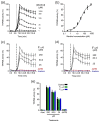L-Menthol-Loadable Electrospun Fibers of PMVEMA Anhydride for Topical Administration
- PMID: 34834260
- PMCID: PMC8618103
- DOI: 10.3390/pharmaceutics13111845
L-Menthol-Loadable Electrospun Fibers of PMVEMA Anhydride for Topical Administration
Abstract
Poly(methyl vinyl ether-alt-maleic anhydride) (PMVEMA) of 119 and 139 molecular weights (P119 and P139, respectively) were electrospun to evaluate the resulting fibers as a topical delivery vehicle for (L-)menthol. Thus, electrospinning parameters were optimized for the production of uniform bead-free fibers from 12% w/w PMVEMA (±2.3% w/w menthol) solutions, and their morphology and size were characterized by field emission scanning electron microscopy (FESEM). The fibers of P119 (F119s) and P139 (F139s) showed average diameter sizes of approximately 534 and 664 nm, respectively, when unloaded, and 837 and 1369 nm when loaded with menthol. The morphology of all types of fibers was cylindrical except for F139s, which mostly displayed a double-ribbon-like shape. Gas chromatography-mass spectrometry (GC-MS) analysis determined that not only was the menthol encapsulation efficiency higher in F139s (92% versus 68% in F119s) but also that its stability over time was higher, given that in contrast with F119s, no significant losses in encapsulated menthol were detected in the F139s after 10 days post-production. Finally, in vitro biological assays showed no significant induction of cytotoxicity for any of the experimental fibers or in the full functionality of the encapsulated menthol, as it achieved equivalent free-menthol levels of activation of its specific receptor, the (human) transient receptor potential cation channel subfamily M (melastatin) member 8 (TRPM8).
Keywords: PMVEMA; TRPM8; electrospinning; menthol; microfibers; nanofibers; viability.
Conflict of interest statement
The authors declare no conflict of interest.
Figures





Similar articles
-
Development of A New Delivery System Based on Drug-Loadable Electrospun Nanofibers for Psoriasis Treatment.Pharmaceutics. 2019 Jan 4;11(1):14. doi: 10.3390/pharmaceutics11010014. Pharmaceutics. 2019. PMID: 30621136 Free PMC article.
-
Poly(methyl vinyl ether-alt-maleic acid) and ethyl monoester as building polymers for drug-loadable electrospun nanofibers.Sci Rep. 2017 Dec 8;7(1):17205. doi: 10.1038/s41598-017-17542-4. Sci Rep. 2017. PMID: 29222482 Free PMC article.
-
The Effect of Poly(methyl vinyl ether-alt-maleic acid) Stabilizer on the Stability of Polyaniline-Poly(methyl vinyl ether-alt-maleic acid) Dispersions.J Colloid Interface Sci. 2000 Jul 15;227(2):316-321. doi: 10.1006/jcis.2000.6898. J Colloid Interface Sci. 2000. PMID: 10873315
-
Current View of Ligand and Lipid Recognition by the Menthol Receptor TRPM8.Trends Biochem Sci. 2020 Sep;45(9):806-819. doi: 10.1016/j.tibs.2020.05.008. Epub 2020 Jun 9. Trends Biochem Sci. 2020. PMID: 32532587 Free PMC article. Review.
-
The distinctive role of menthol in pain and analgesia: Mechanisms, practices, and advances.Front Mol Neurosci. 2022 Oct 5;15:1006908. doi: 10.3389/fnmol.2022.1006908. eCollection 2022. Front Mol Neurosci. 2022. PMID: 36277488 Free PMC article. Review.
Cited by
-
Natural antibiotics against antimicrobial resistance: sources and bioinspired delivery systems.Braz J Microbiol. 2024 Sep;55(3):2753-2766. doi: 10.1007/s42770-024-01410-1. Epub 2024 Jun 18. Braz J Microbiol. 2024. PMID: 38888693 Free PMC article. Review.
-
Electrochemical Detection of Cortisol by Silver Nanoparticle-Modified Molecularly Imprinted Polymer-Coated Pencil Graphite Electrodes.ACS Omega. 2023 Aug 2;8(32):29202-29212. doi: 10.1021/acsomega.3c02472. eCollection 2023 Aug 15. ACS Omega. 2023. PMID: 37599971 Free PMC article.
-
Phytochemical-Based Nanomaterials against Antibiotic-Resistant Bacteria: An Updated Review.Polymers (Basel). 2023 Mar 10;15(6):1392. doi: 10.3390/polym15061392. Polymers (Basel). 2023. PMID: 36987172 Free PMC article. Review.
References
-
- Guilherme V.A., Ribeiro L.N.M., Tofoli G.R., Franz-Montan M., de Paula E., de Jesus M.B. Current Challenges and Future of Lipid Nanoparticles Formulations for Topical Drug Application to Oral Mucosa, Skin, and Eye. Curr. Pharm. Des. 2017;23:6659–6675. doi: 10.2174/1381612823666171122103849. - DOI - PubMed
Grants and funding
- RTI2018-097189-B-C21/Spanish Ministry of Economy and Competitiveness
- RTI2018-101969-J-I00/Spanish Ministry of Economy and Competitiveness
- MAT-2017-86805-R/Spanish Ministry of Economy and Competitiveness
- PTA2018-015394-I/Spanish Ministry of Science, Innovation and Universities
- GVA-IDIFEDER_2018/020 "Una forma de hacer Europa"/Generalitat Valenciana (Spain) and co-financed with ERDF funds
LinkOut - more resources
Full Text Sources
Miscellaneous

